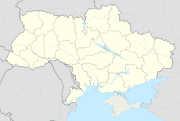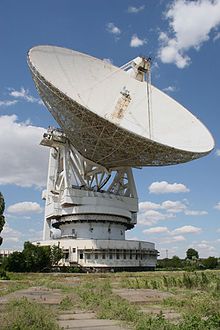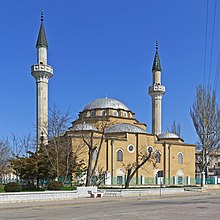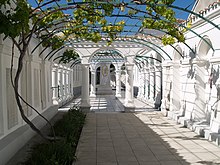Yevpatoria
| Yevpatoria | ||
| Євпаторія | ||
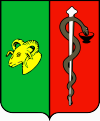
|
|
|
| Basic data | ||
|---|---|---|
| Oblast : | Autonomous Republic of Crimea | |
| Rajon : | District-free city | |
| Height : | 10 m | |
| Area : | 120.7 km² | |
| Residents : | 123,777 (2012) | |
| Population density : | 1,025 inhabitants per km² | |
| Postcodes : | 297400-297490 | |
| Area code : | +380 6569 | |
| Geographic location : | 45 ° 12 ' N , 33 ° 22' E | |
| KOATUU : | 110900000 | |
| Administrative structure : | 1 city, 3 SsT | |
| Mayor : | Andri Danylenko | |
| Address: | пр. Ленина 2 297416 г. Евпатория |
|
| Website : | http://www.kalamit.info/ | |
| Statistical information | ||
|
|
||
Evpatorija or Eupatoria ( Ukrainian Євпаторія ; Russian Евпатория , Crimean Tatar Kezlev , Greek ancient Κερκινίτις Kerkinitis , Armenian Եվպատորիա ) is a coastal city in the Autonomous Republic of Crimea with about 120,000 inhabitants.
geography
The city is located on the west coast of the Crimean peninsula on the shores of the Black Sea . It has a seaport , two train stations and a tram . In addition to the city itself, the city council also includes three urban-type settlements: Saoserne (Заозерне), Myrnyj (Мирний) and Nowooserne (Новоозерне). Evpatoria closes Kalamita Bay to the north.
history
Around 500 BC Greek colonists from Herakleia Pontike founded the ancient city of Kerkinitis here in an area probably populated by Scythians and Sarmatians . In 2003 the city celebrated its 2500th anniversary.
In 1783 Evpatoria came to Russia. In the Russian Empire, Yevpatoria belonged to the Taurian Governorate , which existed until October 1921. After the October Revolution , it was part of the ASSR of Crimea within the Russian SFSR .
In 1855 the Battle of Evpatoria took place as part of the Crimean War .
In the 19th century, the former Fontannoi Uliza (today: Uliza Revoluzii No. 42) was a branch of the Russian steamship company ROPiT, which was based in Odessa and St. Petersburg .
In 1915 a branch line of the Sevastopol – Kharkiv railway line, ending in Yevpatoria , was opened.
By resolution of the Supreme Soviet of the USSR on the occasion of the 300th anniversary of the Treaty of Pereyaslav , Evpatoria and the Crimean Oblast were annexed to the Ukrainian Soviet Socialist Republic on April 26, 1954 . From 1991 to 2014 Yevpatoria was part of independent Ukraine.
Since the internationally unrecognized annexation of the Crimean peninsula to Russia in March 2014, Yevpatoria has de facto belonged to the federal subject of Southern Russia of the Russian Federation. De jure, according to the administrative-territorial division of Ukraine, Evpatoria is part of the Autonomous Republic of Crimea , which is one of the territories occupied by Russia.
population
Composition of the population according to the 2001 census:
|
Town twinning
-
 Portugal : Figueira da Foz since 1989
Portugal : Figueira da Foz since 1989 -
 Germany : Ludwigsburg since 1992
Germany : Ludwigsburg since 1992 -
 Greece : Zakynthos since 2002
Greece : Zakynthos since 2002 -
 Poland : Ostrowiec since 2004
Poland : Ostrowiec since 2004 -
 Turkey : Silifke since 2005
Turkey : Silifke since 2005 -
 Russia : Krasnogorsk Raion since 2006
Russia : Krasnogorsk Raion since 2006
-
 Greece : Lamia since 2009
Greece : Lamia since 2009
-
 Russia : Belgorod since 2010
Russia : Belgorod since 2010
Culture and sights
Evpatoria is of touristic importance, there is a well-developed beach promenade, parks near the banks and avenues in the center. Near Yevpatoria, in Popiwka which took until 2013 Techno Festival KaZantip place, which attracted up to 100,000 people. The city has a cultural diversity typical of Crimea. In addition to the Russian Orthodox Nikolaj Church, built in 1898, the Dschuma-Dschami mosque , built around 1600 by the Turkish builder Sinan , is maintained. One of the few still active Karaite communities in Eastern Europe is also located here .
Until 2014, the orbit tracking and measurement complex of the Ukrainian space agency NSAU was located in Yevpatoria .
Particularities:
- 70 m radio telescope RT-70
- Russian Orthodox Nikolaj Church
- Juma Jami Mosque
- Kenessa , the house of worship of the Karaites
- Monument to the German occupation forces
- Monument of Khortizja
- Miracle healer statue
- Typical old shops
- Old American Embassy
- A house in which all pilgrims can sleep for one night for free
traffic
The main road P25 leading to Simferopol begins in Evpatoria .
tram

The meter-gauge tram network opened in 1914 today consists of four lines with a total length of 22 kilometers. The lines 1 and 2 are important diameter lines , the line 3, a 900-meter-long branch line through the Uliza Frunse , between the head station Yevpatoria health resort and town center, where a transition possibility to the line 1 is composed. Line 4 is about one kilometer long, connects to line 1 and runs along the road to Simferopol to the vicinity of the railway station Pl 54km . Lines 2 and 4 are only operated in the summer season.
The route network was originally laid out on a single track with switches . With the exception of a new double-track section between Uliza Internationalnaja and Sputnik-1 on Line 1, this is still the case today. Since establishment of three turning loops to speed up the operation in the 1950s, the line 1 is of facility vehicles serviced.
The fleet consists of Gothaer T57 / B57 trains and Tatra KT4SU . Of the originally 23 Gothaer railcars and 21 sidecars , five railcars and one sidecar are still in use, they run on lines 2, 3 and 4. The sidecars were converted into control cars. Of the original 18 KT4SU, 14 are still available. Of these, three were converted into bidirectional vehicles with doors on only one side in 2006 and 2007 . They are usually used on lines 3 and 4, where all stops are on the same side. The tram is complemented by 22 bus routes.
Personalities
sons and daughters of the town
- Wassili Kalafati (1869–1942), composer
- Isaak Duwan (1873–1939), actor and director
- Sergei Sokolow (1911–2012), Marshal and Defense Minister of the Soviet Union
- Alexander Davydow (1912-1993), physicist
- Maria Gorokhovskaya (1921-2001), gymnast
- Swetlana Hodschasch (1923-2008), Egyptologist
- Lyudmila Alexejewa (1927–2018), historian and human rights activist
- Anatolij Ponomarenko (1947–2008), Soviet / Ukrainian diplomat
- Edith Suchodrew (* 1953), visual artist
- Anatolij Reshetnyak (* 1955), Ukrainian middle-distance runner
- Jelena Belewskaja (* 1963), Belarusian athlete
- Ruslana Taran (* 1970), Ukrainian sailor
- Iryna Fris (* 1974), Ukrainian politician
- Alexander Dimitrenko (* 1982), German boxer
- Xenia Simonowa (* 1985), Ukrainian artist
Connected to the city
- The church musician Siegfried Bauer (* 1944), who founded the Chamber Orchestra Yevpatoria in 1995, received the "Mayor Duwan Order" for his musical activities and was made an honorary citizen.
- Natalja Poklonskaja (* 1980), Attorney General of the Republic of Crimea, grew up in the city and lived there until 2010.
Web links
Individual evidence
- ↑ In 1784 the city was given the Russian name "Евпатория" (Evpatorija). This name is derived from the nickname Eupator ("from a good father") and here refers to Mithridates VI., King of Pontus
- ↑ www.cidct.org ( Memento of the original from November 21, 2008 in the Internet Archive ) Info: The archive link was automatically inserted and not yet checked. Please check the original and archive link according to the instructions and then remove this notice.
- ↑ Compare the images on the website Architekturportal der Krim for the historical office building .
- ↑ The Transfer of the Crimea to the Ukraine (English)
- ↑ Федеральный закон Российской Федерации от 21 марта 2014 года № 6-ФКЗ "О принятии в Российскую Федерацию Республики Крым и образовании в составе Российской Федерации новых субъектов - Республики Крым и города федерального значения Севастополя"
- ↑ Annexation of the Crimea. Putin violates Russian constitution
- ↑ Дністрянський М. С. Етнополітична географія України. Львів: Літопис, 2006. С.452-453
- ↑ http://www.kalamit.info/index.php?p=news&area=1&newsid=2389&print=1
- ↑ Idyll in the Crimea in: Tram Magazin 3/2019, p. 32 ff.
